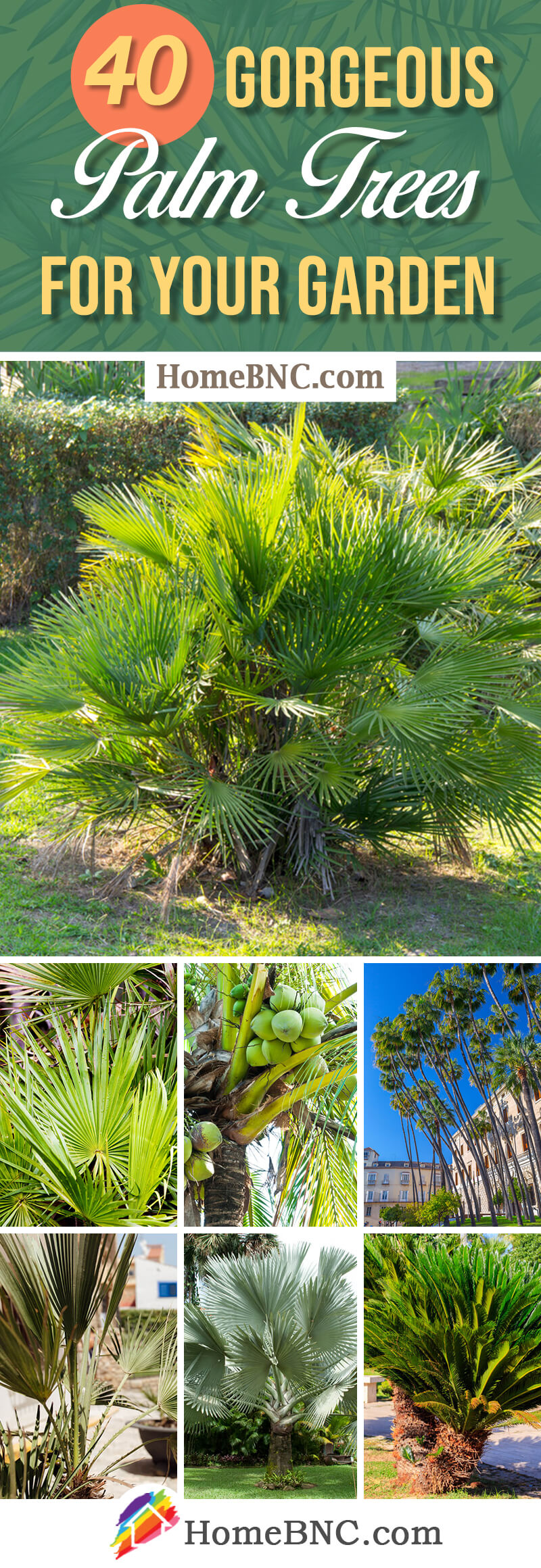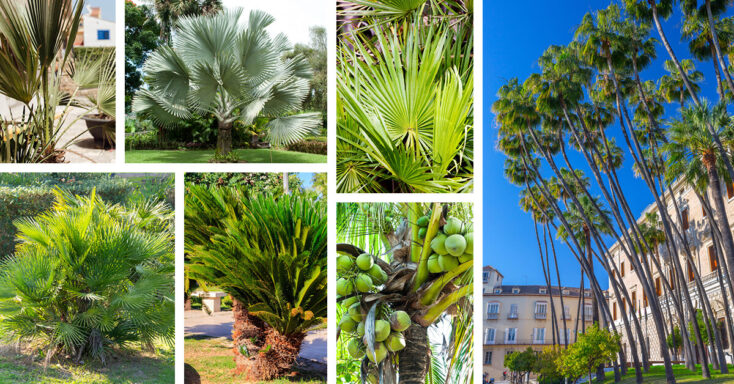When you want to create a garden with a distinct topical look, then types of palm trees are one of the first plants that you’ll think of planting. However, what few people know is that palm trees come in more varieties than you could count. The reason for this is that the plants we commonly call palms come from many different genera, which leads to plenty of variety. That variety includes palms that grow quickly and slowly, large and small, indoors and out. To give you a better sense of the many palm trees you can grow in your landscape, we have assembled a collection of the 40 best varieties around.
Key Takeaways
It is truly astounding to learn about how many different beautiful palms there are out there. That vast volume of species also means that there is a lot to learn about this large plant family. However, in this particular article, you can expect to come away with these five facts will prove to be true as you read through the list.
- There are many different types of palm trees.
- As a plant group, palm trees include many different species and genera.
- Palm trees can be large and tree-like or smaller and more shrub-like.
- Some palm trees produce popular fruits.
- Palm trees can grow outdoors in some regions and indoors anywhere else.
40 Types of Palm Trees You Can’t Pass Up
1. Needle Palm (Rhapidophyllum hystrix)
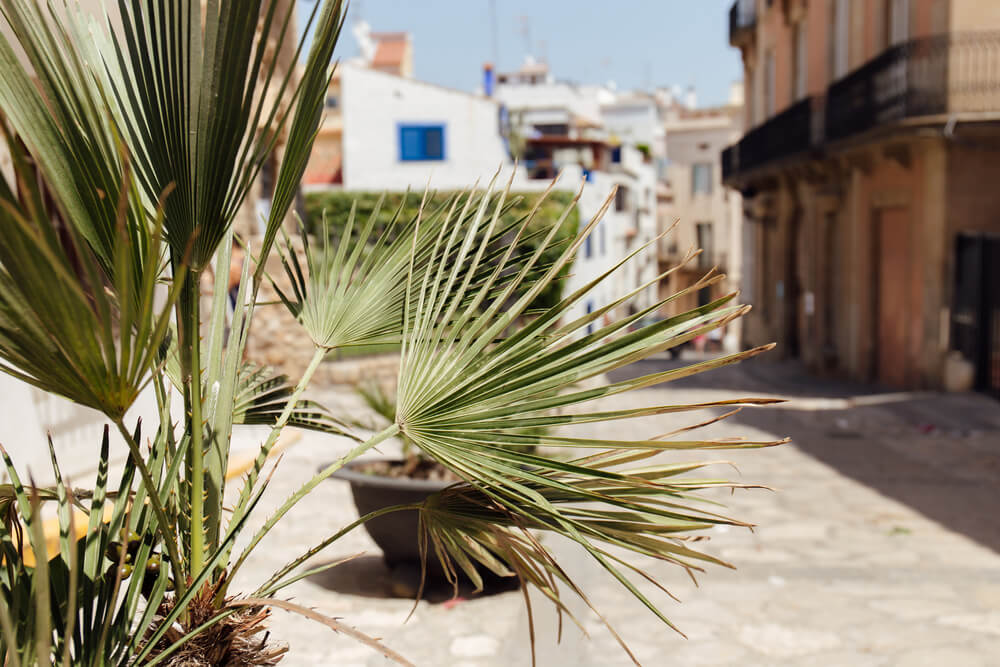
The needle palm is not a particularly large palm tree, as it reaches only a few feet tall and wide at maturity, which makes for a very shrub-like appearance. But what the needle palm lacks in size, it makes up for in cold hardiness. Unlike many other palms, the needle palm can survive in both hot and relatively cool climates. In some cases, it can withstand temperatures that drop below 0 degrees Fahrenheit. At times, this plant can go by the name porcupine palm, and it comes with a set of sharp spikes that appear between each of the leaves. Because of those spikes, you should use caution when pruning or otherwise handling this plant to avoid getting cut.
2. Coconut Palm (Cocos nucifera)
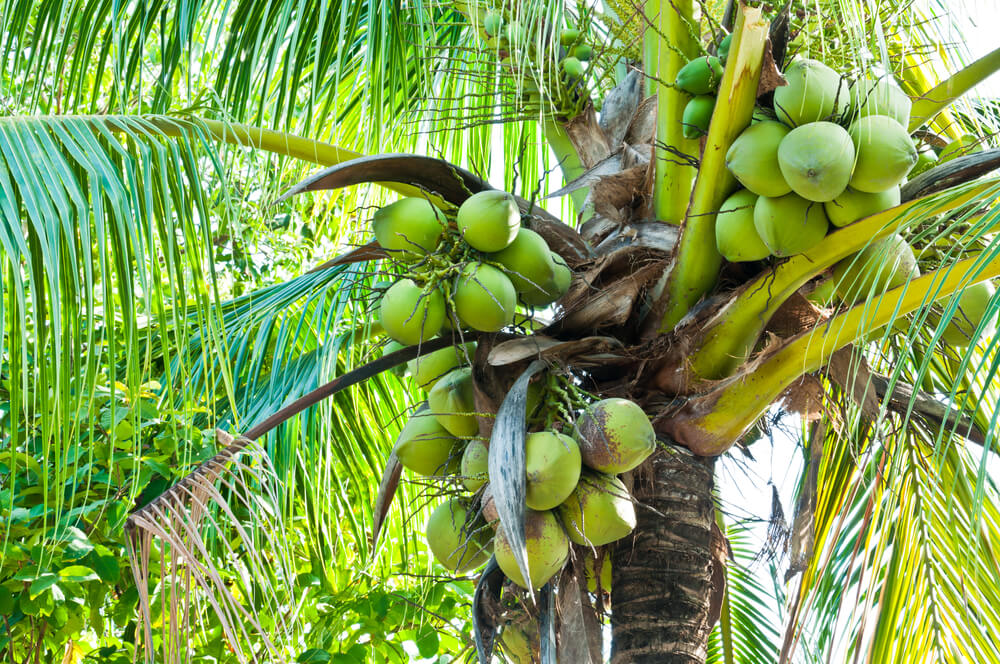
Many are aware that coconut trees and palm trees are common throughout tropical climates, but were you aware that the coconut tree is, in fact, a type of palm? This entry on our list, which goes by the botanical name Cocos nucifera, is the plant that we commonly call the coconut tree or coconut palm. The coconut palm can grow to incredible heights and develops large coconut fruits that appear in bunches at the top of the plant. If you live in a climate that can support this species, you can enjoy harvesting those delicious coconut fruits in your own yard.
3. European Fan Palm (Chamaerops humilis)
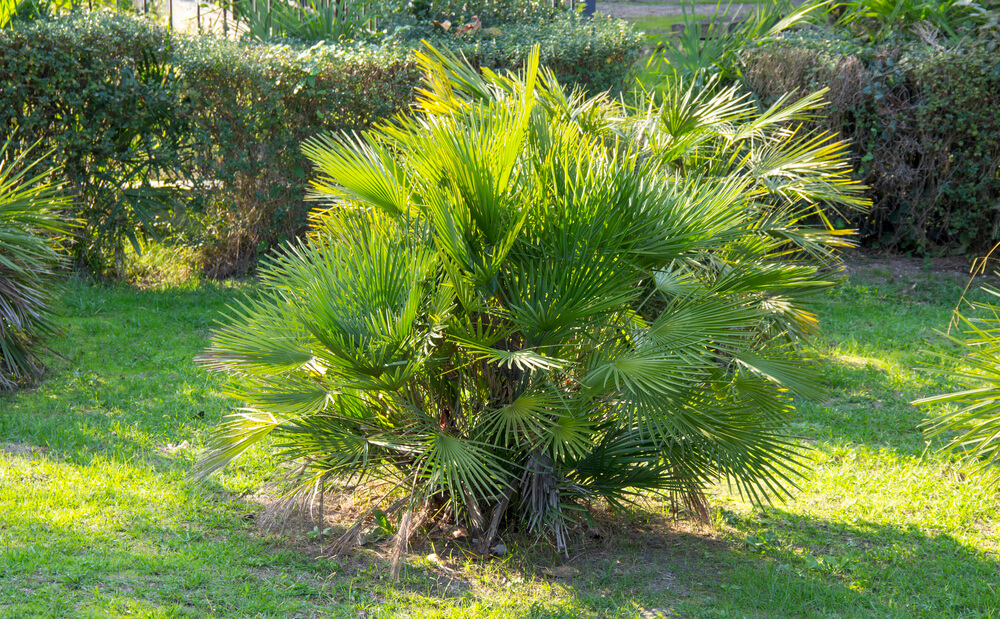
It is great to know that there are plenty of palm tree options for those who want a large plant and plenty of options for those who want a smaller one. This entry on our list belongs to that second group. The European fan palm tree is not only small overall, growing to 15 feet tall at most, but it is also a slow-growing palm tree variety. This species steadily develops its large, fan-shaped fronds while maintaining a compact habit. Those fronds can be incredibly attractive thanks to their prominent shape and the subtle silvery green hue that they can hold.
4. Chinese Fan Palm (Livistona chinensis)
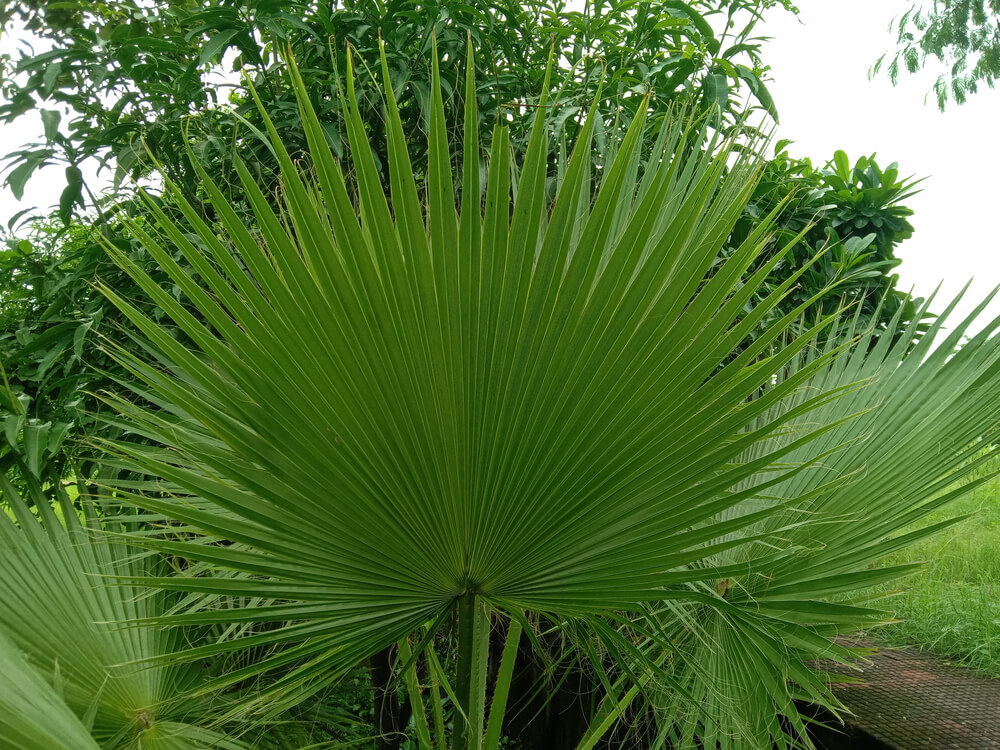
The Chinese fan palm tree is another example of a palm that has large, broad fronds that give it a distinct appearance. Similar to the European fan palm tree, this palm grows more like a bush than a tree. But the Chinese fan palm is even smaller, often growing to only 6 feet tall at most. That small stature makes the Chinese fan palm a fantastic option for indoor gardening. This plant proves to adapt well to growing in containers and does not grow large enough to overcrowd your indoor living areas. Give this plant access to several hours of sunlight per day, and it should perform well for years to come.
5. Mexican Fan Palm (Washingtonia robusta)
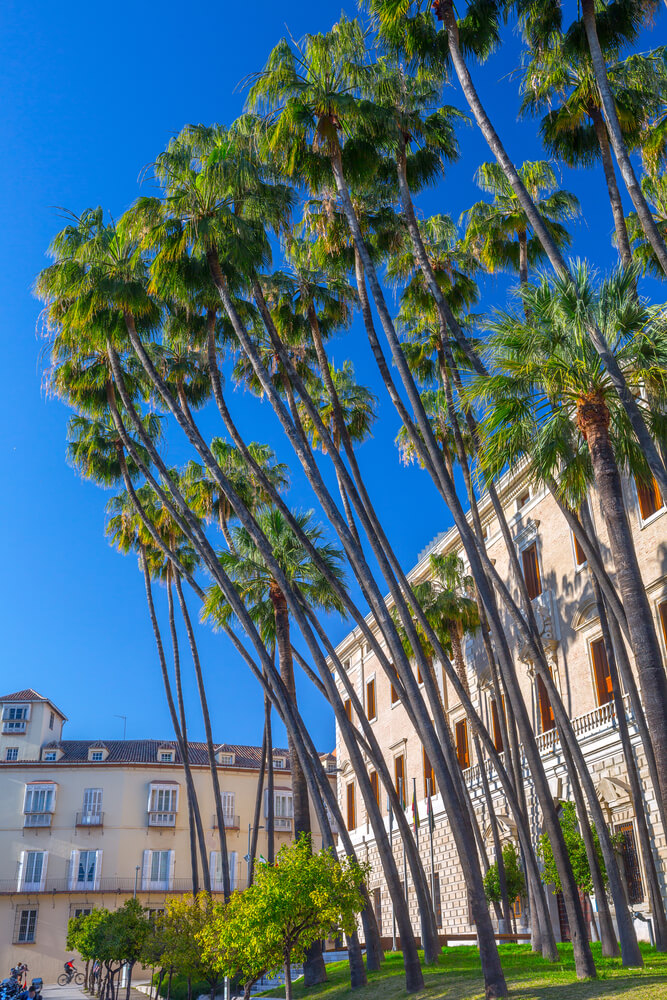
Much like the other fan types of palm trees we have mentioned on this list thus far, the Mexican fan palm tree has large leaves that take the shape of a fan. But what makes this plant different from those other fan palms is its size. The Mexican fan palm may start out looking shrubby, but it can grow to be a 100-foot tree when conditions are right. Another interesting aspect of this tree is that when its leaves die, they do not fall off the tree. Due to that feature, it’s important to prune out dead leaves when you can to prevent the canopy from getting too dense, which can lead to disease.
6. California Fan Palm (Washingtonia filifera)
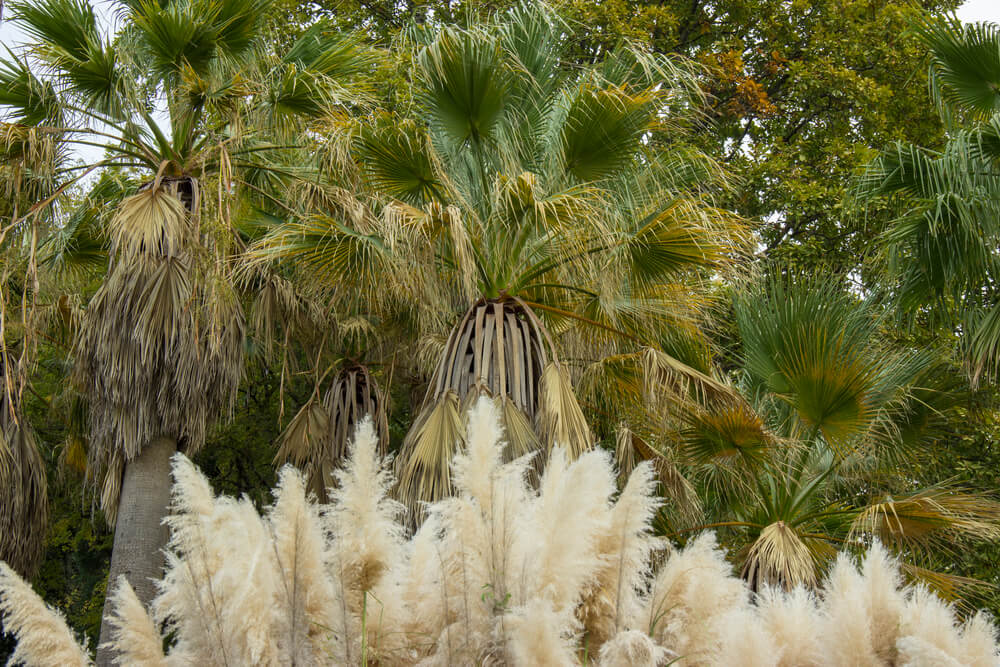
While there are countless palm tree varieties throughout the world, only a small percentage of them are native to North America. This entry, the California fan palm tree, is the largest of those North American natives. It can grow to 80 feet tall with leaves that can be up to 5 feet long. People sometimes call this plant the desert fan palm since desert climates are where you often find this plant growing in the wild. However, the California fan palm tree can grow in mountainous regions as well. For anyone in the United States that is interested in both palm trees and native plantings, the California fan palm may be the pick for you.
7. Types of Palm Trees: Palmetto (Sabal palmetto)

Known as the cabbage palm, cabbage palmetto, or simply the palmetto, this tree is one of the most popular and well-known types of palm trees in the United States. In fact, the palmetto is the official state tree for Florida and South Carolina, the latter of which people even refer to as the palmetto state. Along with being famous, the palmetto palm is also a very attractive palm tree. When mature, it consists of a single main trunk that holds a cluster of fronds at the top. When pruned in a certain way, the palmetto palm can also develop a distinct cross-hatch pattern on its trunk after removing spent fronds.
8. Dwarf Palmetto (Sabal minor)
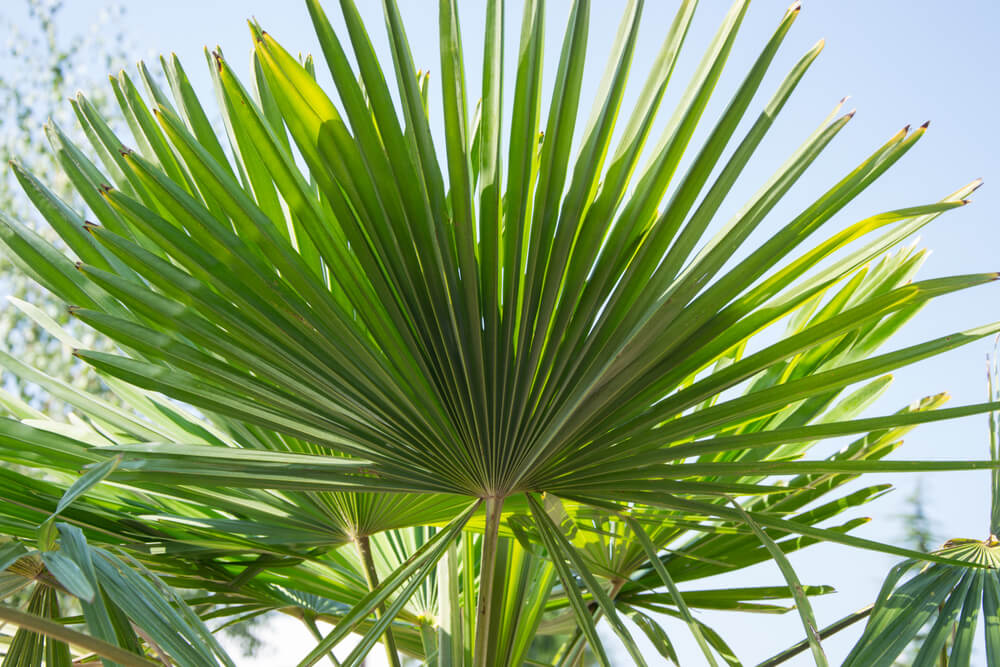
If you are fond of the well-known palmetto palm tree, then maybe you should try the dwarf palmetto as well. Both of these trees are species that belong to the same genus, but the major difference is that the dwarf palmetto grows to be about 5 to 10 feet tall at maturity. This tree has large fan-shaped leaves, and it thrives throughout areas of Mexico as well as southern parts of the United States. But thanks to its smaller size, the dwarf palmetto remains an indoor planting option for those in colder regions. Regardless of where you grow this plant, you’ll find that it can adapt well to a relatively wide range of growing conditions.
9. Saw Palmetto (Serenoa repens)

Despite having a similar common name, the saw palmetto does not belong to the same genus as the palmetto and dwarf palmetto that we mentioned elsewhere on this list. However, these plants still share enough of a similarity in appearance that they also share a similar common name. The saw palmetto stands from those other palm options as being exceptionally popular in the nursery trade. In fact, that popularity has led to several cultivated varieties of this species, which can feature variations in foliage color. Outside of those visual differences, those cultivars generally have a small size and slow overall growth rate.
10. Everglades Palm (Acoelorrhaphe wrightii)
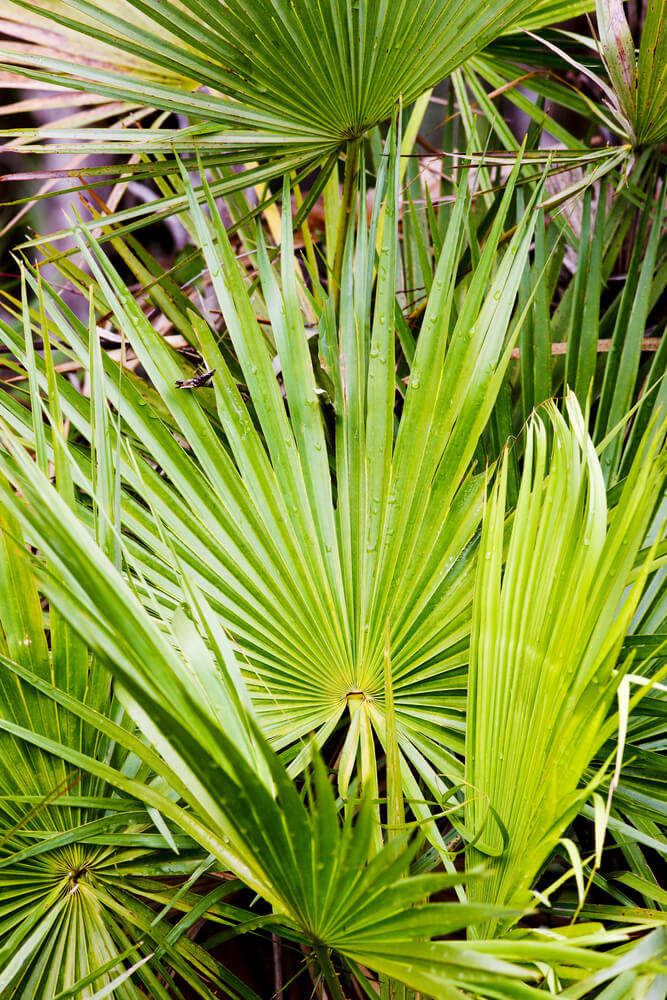
The Everglades palm is a swamp-dwelling palm species that is native to the southeastern United States, the Caribbean, and Central America, which means this palm is an awesome option if you have wetter soils. Unlike other palms, the Everglades palm grows in clusters rather than in a classic tree shape. That dense growth habit can make this species a good option for privacy plantings. However, you should be wary of any stems that fail to develop vertically, as these can bend, twist, and break under their own weight as they increase their size. Still, with the right pruning, the Everglades palm can be an excellent addition to your landscape.
11. Jelly Palm (Butia capitata)
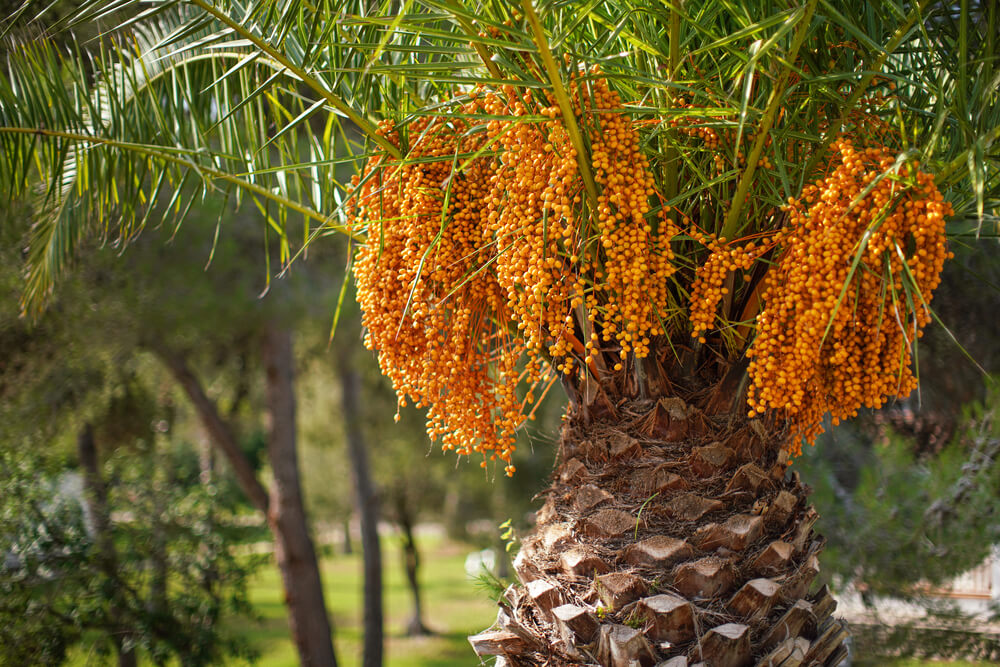
The jelly palm is so-called because each year, it produces a set of sweet fruits that are excellent ingredients for jams or baked goods. Before those fruits arrive, this tree blooms with small creamy flowers that give off a lovely scent. But even if the jelly palm is not currently bearing flowers or fruit, it remains beautiful due to its long arching fronds that present a brilliant shimmering texture in the wind. The Jelly palm also proves to be adaptable to both full sunlight and partial shade settings while withstanding relatively low temperatures compared to most other palms.
12. Bismarck Palm (Bismarckia nobilis)
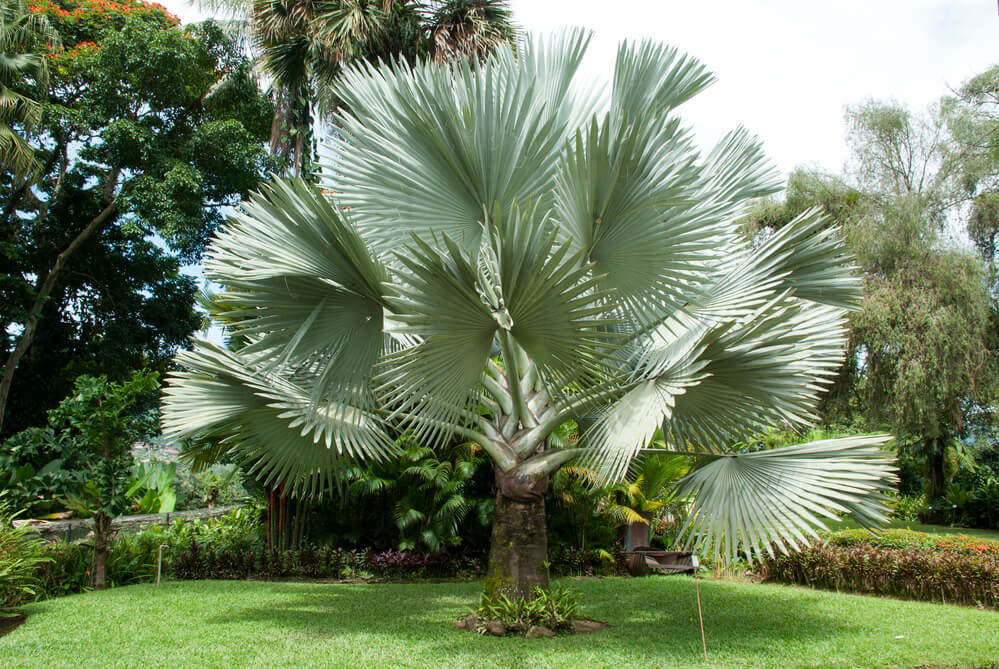
While the foliage of most palm varieties is impressive, the fronds of the Bismarck palm may be the most astoundingly beautiful of all. These fronds are fantastically large with a neat fan shape and a hue that is truly silvery blue. The Bismarck palm also has a single stout trunk upon which those fronds attach themselves. Those remarkable features make the Bismarck palm tree an outstanding focal point in any garden that sits within hardiness zones 10 to 11. In that range, assuming the growing conditions are otherwise suitable, this tree will also display an ability to tolerate drought.
13. Date Palm (Phoenix dactylifera)
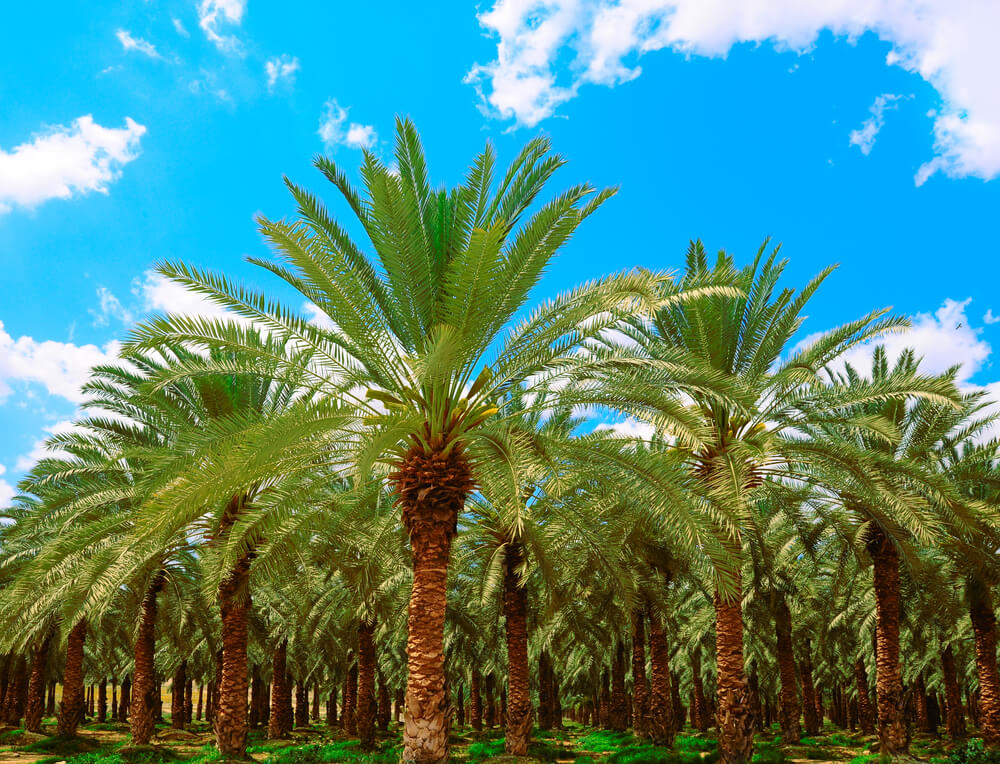
This entry proves once again that palms are not only a quintessential element of certain landscapes, but they are also responsible for producing some of the most popular fruits in the world. For instance, if you plant and grow the species Phoenix dactylifera, you’ll enjoy a bountiful harvest of dates in your very own yard. But even if you don’t plant to harvest from your date palm, you can still enjoy the appearance of those fruits as they hang in prominent red clusters and strike a lovely contrast to the long green fronds that form a canopy above.
14. Canary Island Date Palm (Phoenix canariensis)
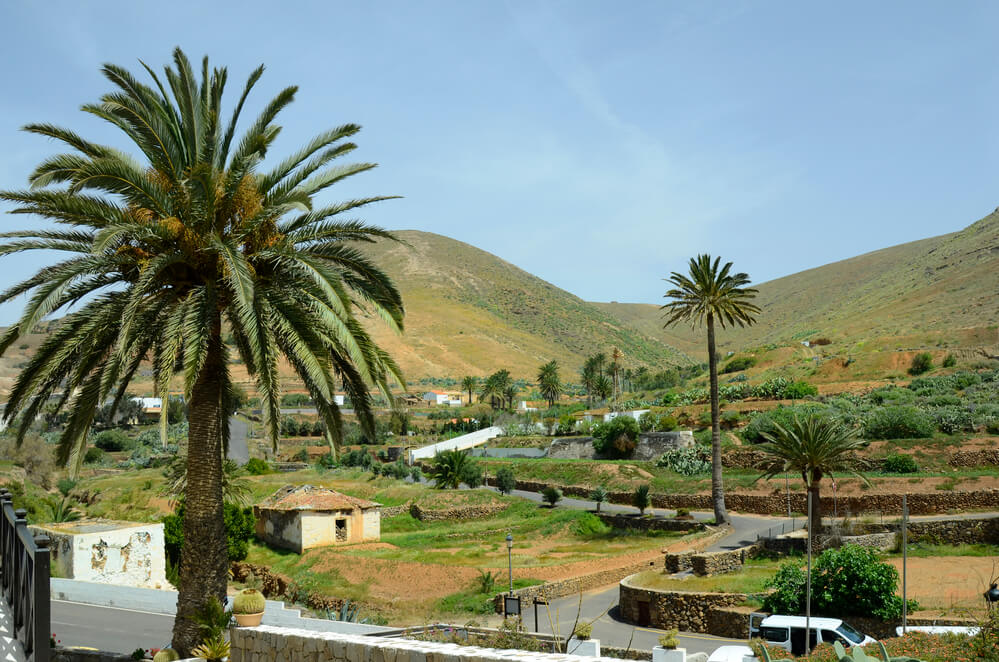
The Canary Island date palm is another exceptionally large palm variety that can reach 90 feet tall when it grows in ideal conditions. However, you won’t need to worry about this palm growing too tall too quickly, as it has a very slow growth rate. In a typical instance, the Canary Island date palm may take more than a decade to reach ten feet tall. Additionally, the Canary Island date palm is not a plant that produces an enjoyable harvest. Although this plant’s fruits look a lot like the dates we commonly eat, they are nearly as agreeable to the pallet, to the point where people rarely consume them.
15. Senegal Date Palm (Phoenix reclinata)

Many types of palm trees grow like a single-stemmed tree or like a neat, rounded shrubs. Such is not the case for the Senegal date palm. This tree grows to about 40 feet tall at most and has a very irregular shape. This irregular shape make the Senegal date palm tree a good option if you want a palm species that deviates a bit from the typical palm growth habit. By choosing a palm that grows a bit differently than most, you’ll be adding a plant to your garden that is sure to have a unique flair.
16. Pygmy Date Palm (Phoenix roebelenii)
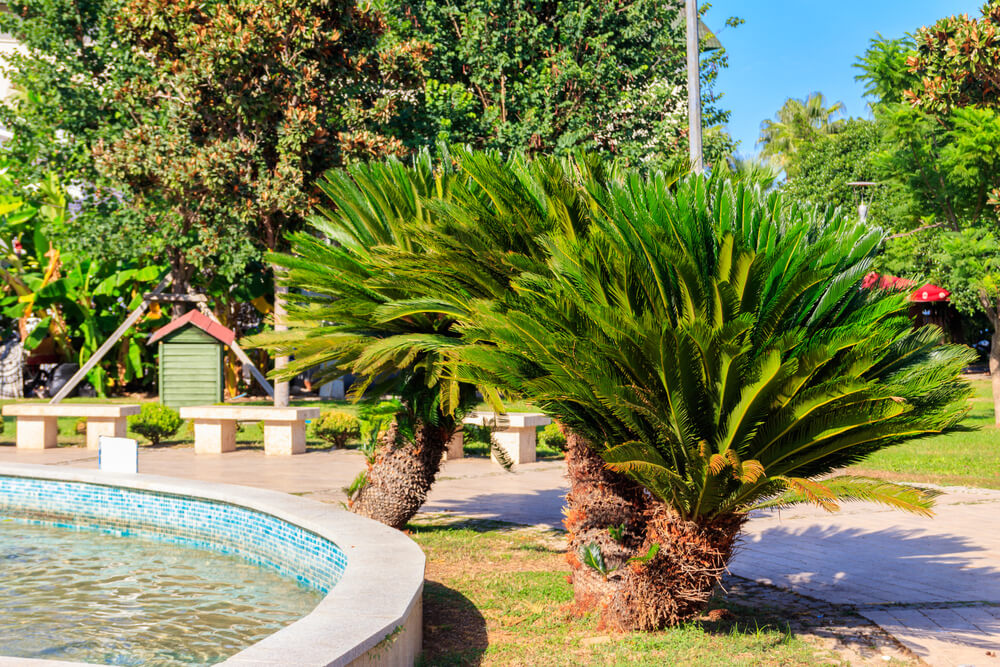
The pygmy date palm hails from southeast Asia but is a popular cultivated plant throughout the world. This palm species can be an excellent addition to outdoor gardens in any region that does not regularly experience temperatures below 25 degrees Fahrenheit. But if you don’t live in such an area, then you should know that the pygmy date palm is another viable option for indoor growing. While this plant won’t produce flowers in most indoor settings, it will give a reliable set of greenery to your home. Just make sure that you don’t let any harsh direct sunlight scorch this plant’s foliage.
17. Wild Date Palm (Phoenix sylvestris)
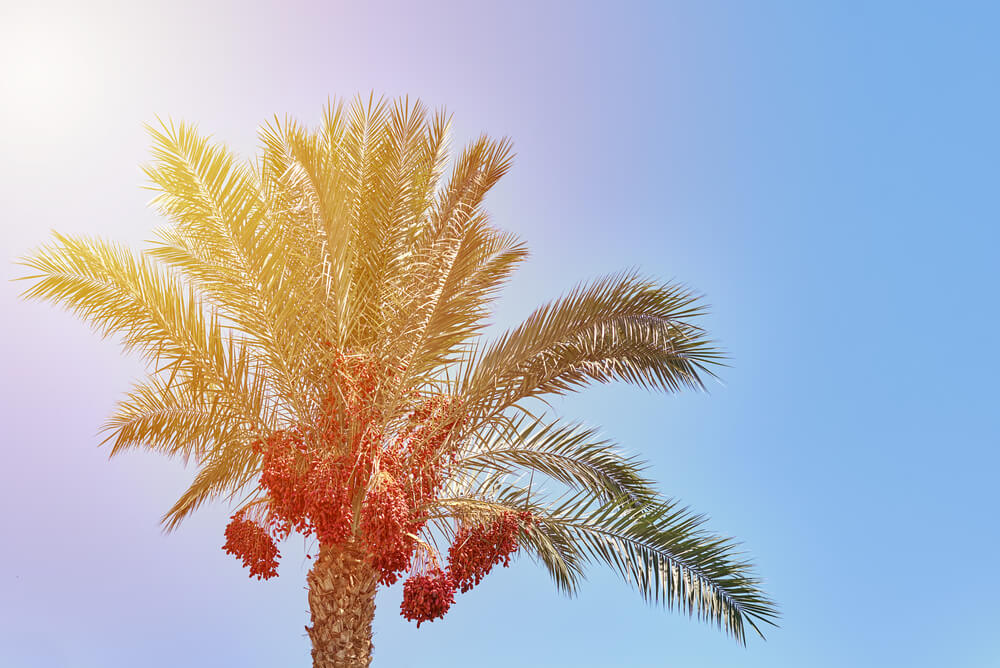
The wild date palm, which sometimes goes by the name Sylvester palm, is another large-scale palm tree that gives us tasty date fruits for harvest. While this plant is large, it is not as large as some of its related species, often growing to about 40 feet tall. Overall, this plant is pretty easy to care for. All you’ll need to do to keep it looking its best is remove any suckers that appear around the base, as well as any fronds that show signs of disease. Providing that maintenance, along with plenty of sunlight and soil drainage, will keep any wild date palms on your property happy and healthy.
18. Queen Palm (Syagrus romanzoffiana)

Compared to most other palms, the queen palm is one of the more stately, if not regal, options of all. This palm grows with a slender trunk that rises nearly perfectly straight up towards the sky. At the top of that trunk, this tree holds fronds that can reach as long as 15 feet. If you want to enjoy the beauty of a queen palm in your landscape, be sure to give this plant nutrient-rich soil that is slightly acidic. If the soil is too alkaline, then the queen palm can experience chlorosis, which, while not typically fatal, will change the natural color of this palm’s foliage.
19. Triangle Palm (Dypsis decaryi)

If you are familiar with topiary, then you know that gardening style is the best way to add geometric plants to your garden. But wouldn’t it be convenient if there was a way to include these interesting shapes without the need for constant and meticulous trimming and pruning? If you find yourself asking this question, then the triangle palm is a good option for you. This plant produces new fronds at three distinct angles from the trunk, which results in triangular forms. With some pruning, those shapes will be even more impressive. As such, it’s no surprise that the triangle palm can serve as a great garden focal point.
20. Mazari Palm (Nannorrhops ritchiana)
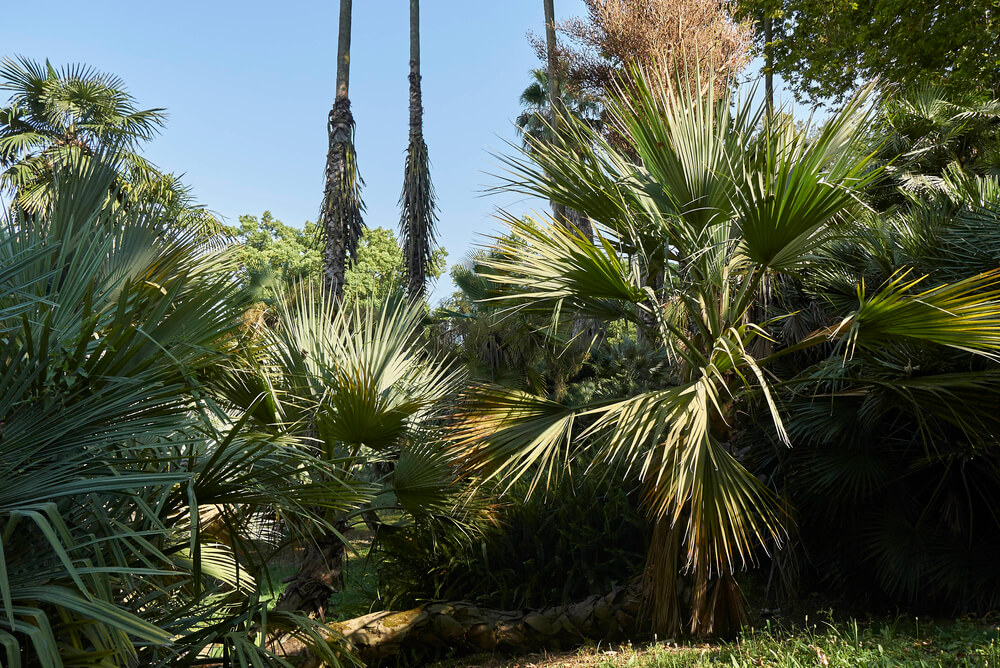
Part of what makes the Mazari palm an interesting variety is that it can adopt one of multiple growth habits. In some cases, this palm will grow like a standard tree with a single trunk. In other instances, the Mazari palm will have a clustered habit that consists of many trunks. Regardless of the overall shape, the leaves of this plant keep the same form no matter what. They are large, fan-shaped, and can droop in an almost weeping habit in some scenarios. Although not commonly grown for this reason, the Mazari palm also produces edible fruits.
21. Dwarf Majesty Palm (Ravenea hildebrandtii)
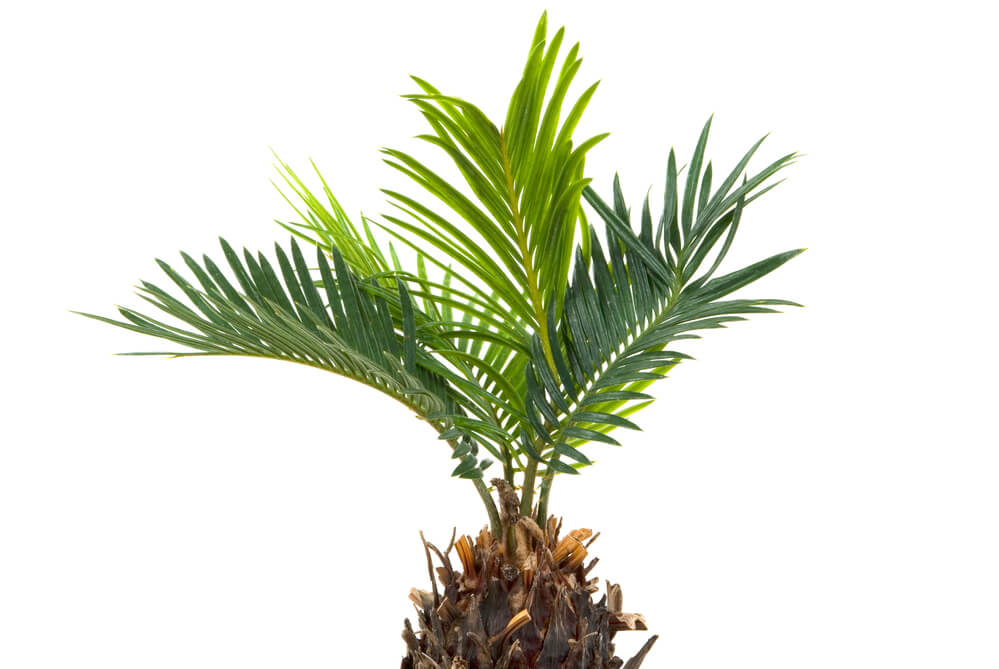
The dwarf majesty palm is the perfect palm to plant if you want a smaller species that still has a traditional palm tree shape. This species does not come close to reaching ten feet tall in most cases and has a single straight trunk that holds long fronds at the top. That combination of physical features makes the dwarf majesty palm a great option for residential landscapes. This palm also has reasonable cold hardiness as it can survive occasional temperature dips below 30 degrees Fahrenheit. However, you should be careful about planting this tree in strong direct sunlight for many hours, as this can lead to wilt.
22. Bottle Palm Tree (Hyophorbe lagenicaulis)
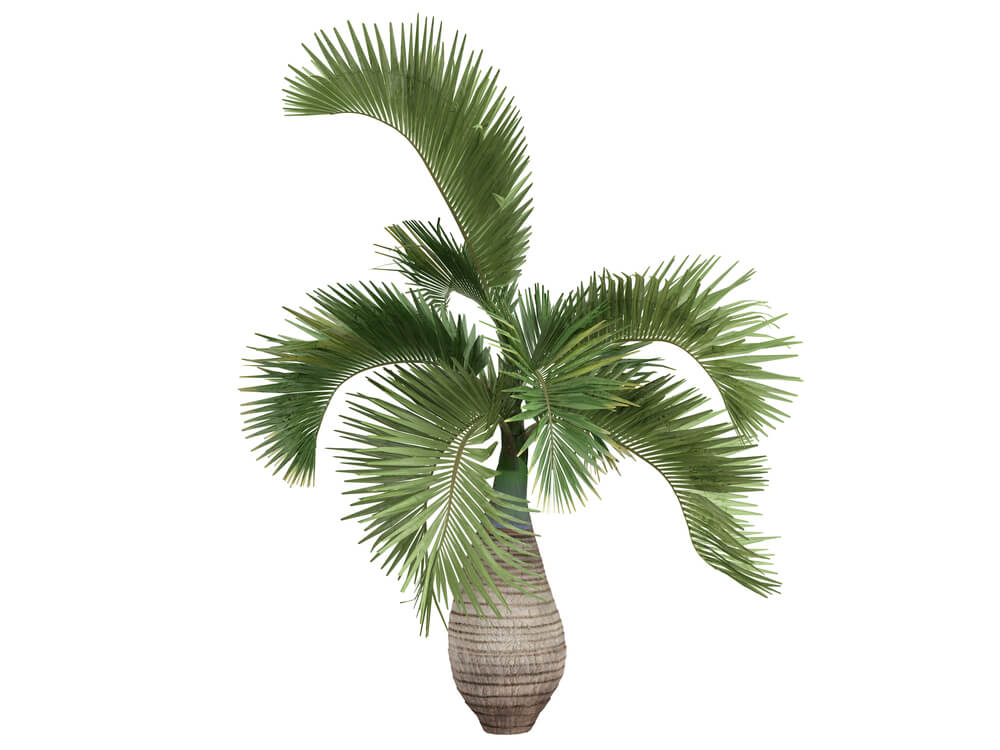
When most people think of a palm tree, prominent leafy fronds are the characteristic they imagine first. By contrast, very few palms, and very few plants in general, stand out due to their trunk traits alone. But the bottle palm tree is one of those rare plant varieties. This palm has an interesting, rounded trunk shape that tapers towards the top to resemble a soda bottle. That intriguing shape allows the bottle palm tree to be a great focal point. Likewise, the arching fronds of this tree will make you like its look even more.
23. Florida Cherry Palm (Pseudophoenix sargentii)

The Florida cherry palm was once widespread throughout the natural areas of Florida and surrounding areas. However, the natural population of this plant has declined significantly. The good news is you can join the many other people who grow this palm as an ornamental species in their yard and, in doing so, help to prevent the extinction of this species. Thankfully, the Florida cherry palm is well suited to residential areas since it is a small but attractive variety. It also produces fruits that are remarkably red and look very much like a cherry.
24. Types of Palm Trees: Chilean Wine Palm (Jubaea chilensis)

The adaptability alone of the Chilean wine palm tree is enough to make it a valuable addition to your gardening repertoire. This plant has shown an ability to grow in soils that range from sandy to loamy, as well as hardiness zones 8 through 11. What makes the Chilean wine palm even more valuable is that it is an incredibly attractive species. Its trunk is thick and strong and carries a copious number of large fronds. Furthermore, the Chilean wine palm also proves to be easy to care for as it has very few pest and disease issues.
25. Florida Royal Palm (Roystonea regia)

When describing the Florida royal palm tree, impressive is the first word that often comes to mind. The Florida royal palm tree has a long life span and can reach incredible heights of 100 feet tall or more. On top of that, this palm tree is native to Florida and has a strong ability to endure strong winds and even some hurricanes. Since it’s a native with a long life, it is no surprise that the Florida royal palm is also a great contributor to the local ecosystem. It’s difficult to deny the striking nature of its light grey trunk as well.
26. Cascade Palm (Chamaedorea cataractarum)
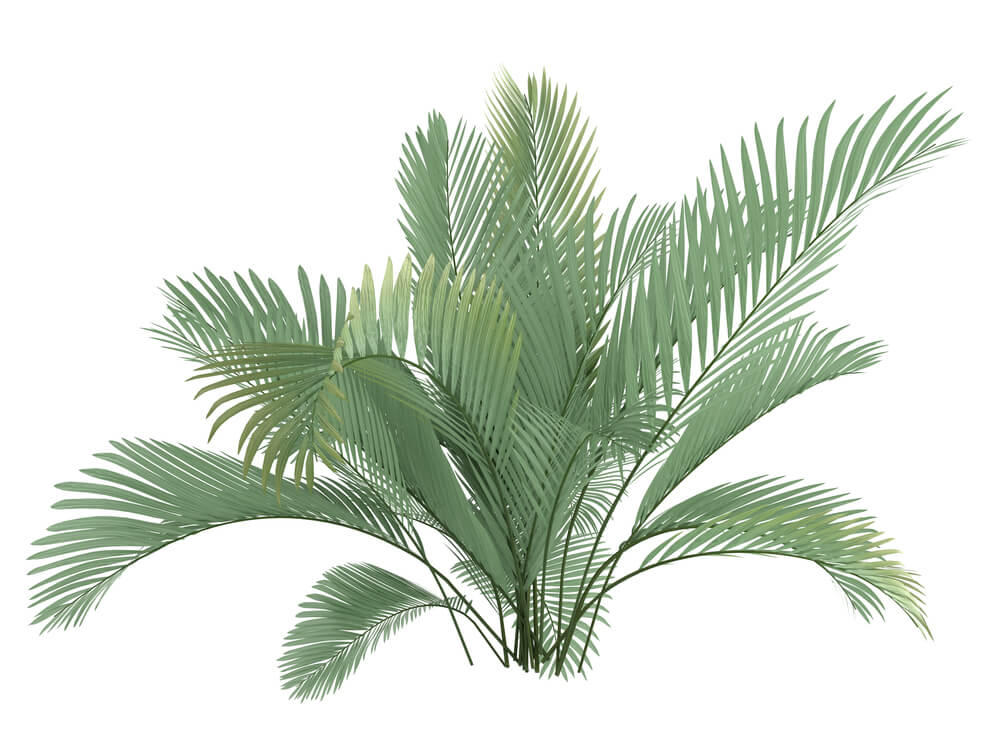
The cascade palm, also known as the cat palm, is one of the smaller palm species on this list. Although this plant comes from regions covering Mexico and Central America, you can find it growing most often as a part of tropical indoor planting schemes throughout the United States. Upon seeing one of these plants, you’ll find that the foliage truly does seem to cascade down from the top of the canopy to the ground. However, to enjoy that foliage for yourself, you’ll need to make sure that you don’t place your cascade palm in direct sunlight for most of the day, as that will cause the foliage to burn.
27. Açaí Palm (Euterpe oleracea)
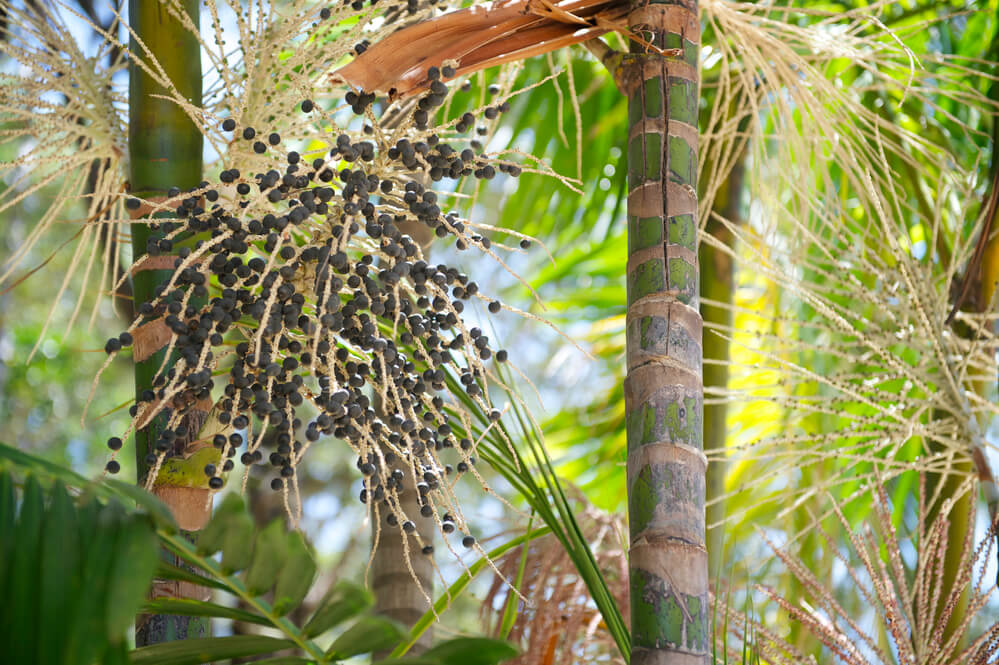
Once again, the palm tree family has gifted us a plant that produces some of the most sought-after fruits in the world. The acai palm tree develops large clusters of dark purple drupe fruits that many people are familiar with as acai berries. Those fruits appear in massive quantities, and it is not uncommon for a single panicle to hold almost 1000 individual fruits. Even though this tree is most well known for those fruits, it is also valuable as an ornamental since it maintains a classic palm shape with tall trunks and long fronds.
28. Oil Palm (Elaeis guineensis)
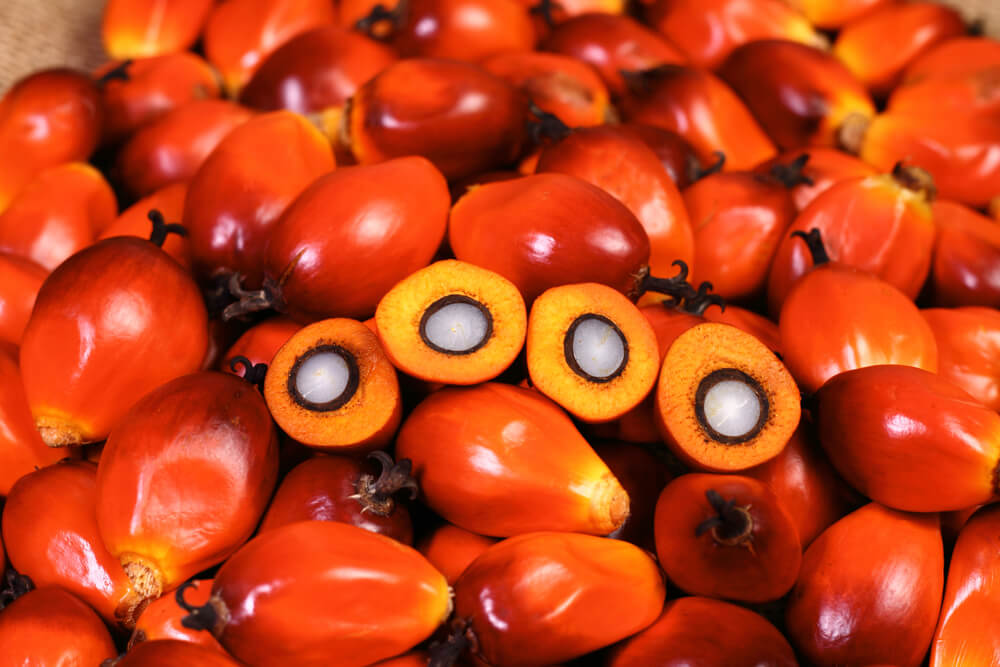
If you have ever heard of or used palm oil, then you should know that the oil palm tree is responsible for producing it. This native African plan combines that economic value with an ornamental appeal. As you remove spent fronds from this plant, a deeply textured bark pattern will appear below the remaining fronds. The other features of this plant can have yellowish or orange hues. This is often true of both the flowers and the fruits of the oil palm, meaning that this plant is capable of adding color to your landscape as well.
29. San Jose Hesper Palm (Brahea brandegeei)
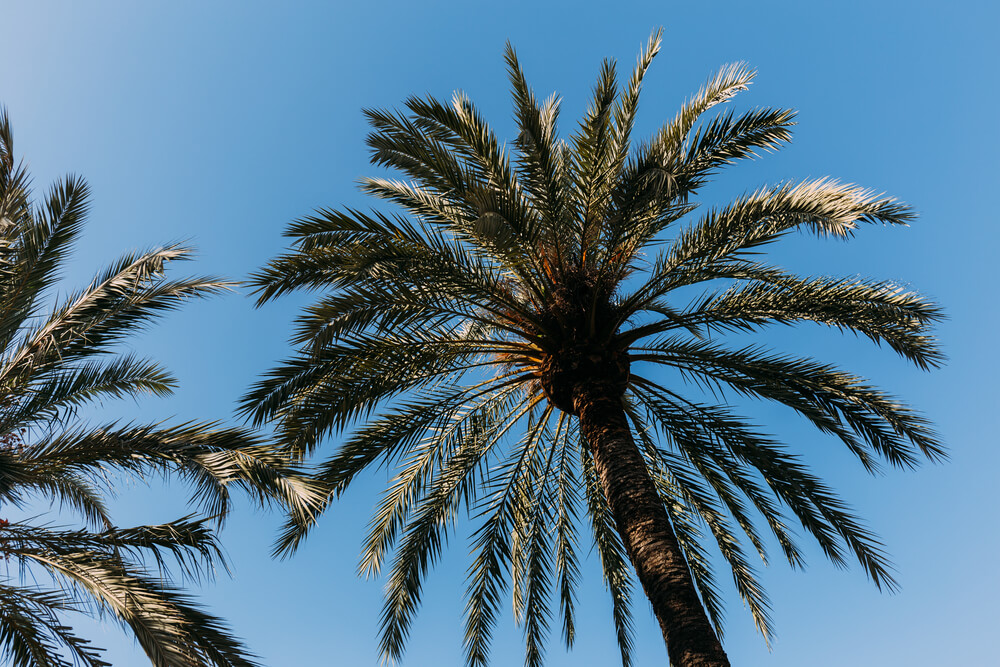
The San Jose Hesper palm tree does not get as much attention as some other palm tree varieties on our list. However, that lack of attention is far from justified. The San Jose Hesper palm tree grows to be quite tall with a single trunk and is a durable tree as well. This palm can survive drought and generally dry growing conditions. Also, as this plant matures, it does not require any pruning from you, as it will begin to drop its spent fronds all on its own.
30. Guadalupe Palm (Brahea edulis)
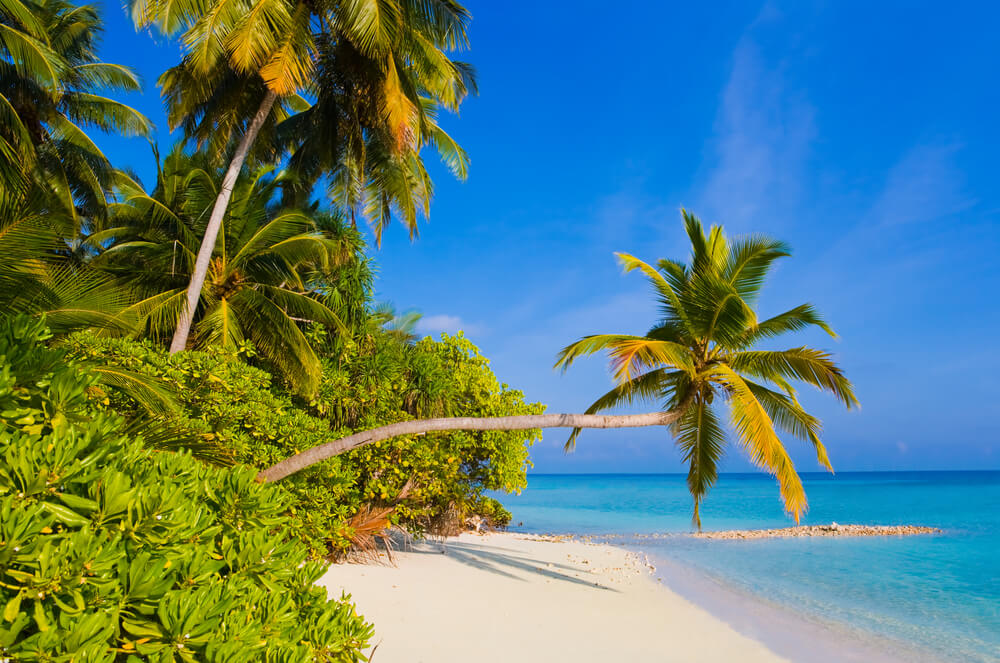
When you first come across a Guadalupe palm tree, you’ll immediately notice this plant’s interesting growth habit. The trunk of this tree can curve as it develops, which sometimes makes mature Guadalupe palm trees look like they are leaning to one side. While the plant is young, the tree maintains its curving trunk that seems to taper from thick to thin, as is true of the bottle palm tree. It may be best to grow a grove of Guadalupe palm trees to allow those interesting trunks to create an even more eye-catching appearance.
31. King Palm (Archontophoenix cunninghamiana)
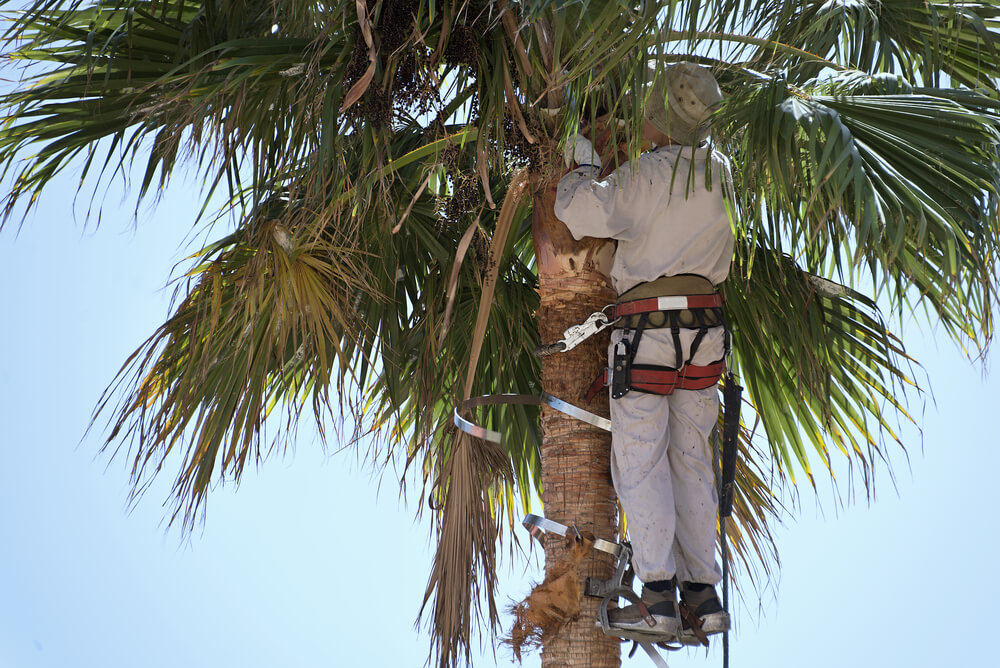
Those who are passionate about palm trees point to the texture these plants provide as a major source of their beauty. One of the best examples of this is the king palm tree. The king palm tree has a dense canopy full of fan-shaped fronds. In any case, the tips of those fonds will droop slightly, which gives the plant a weeping effect. Along with great texture, the king palm tree also gives color in the form of its bright red fruit clusters that stand out boldly against the trunk and canopy.
32. Fishtail Palm (Caryota mitis)
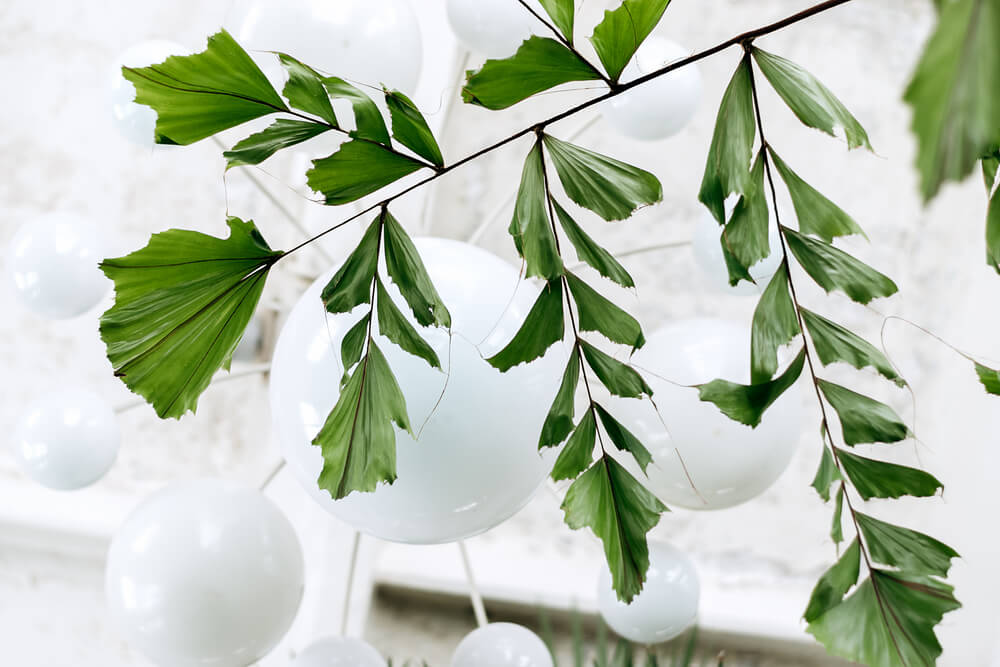
Nearly every palm tree on this list, and in existence, seems to have a fan-shaped frond or a long frond with many long leaflets. However, the fishtail palm is quite different from the norm. The leaves of this tree are nearly triangular with a frayed edge that makes them look like fishtails. The fishtail palm also stands out because it is very versatile. While many types of palm trees need a specific amount of sunlight, the fishtail palm can survive in areas that range from full sun to mostly shade. This gives gardeners in many locations the chance to grow the fishtail palm.
33. Texas Sabal Palm (Sabal mexicana)

Vibrant color contrast is not the first thing that most gardeners associate with a palm tree. However, that is exactly what the Texas sabal palm will provide. The flower clusters of this plant are distinctly yellow, and they hang down below the canopy. That yellow perfectly juxtaposes the true green color of the Texas sabal palm’s fronds. Those fronds are fan-shaped, but unlike other fan-shaped fronds, these ones form a nearly perfect semi-circle. With full sunlight and occasional deep watering, this palm tree will continue to elevate the look of your garden for many seasons.
34. Alexandra Palm (Archontophoenix alexandrae)
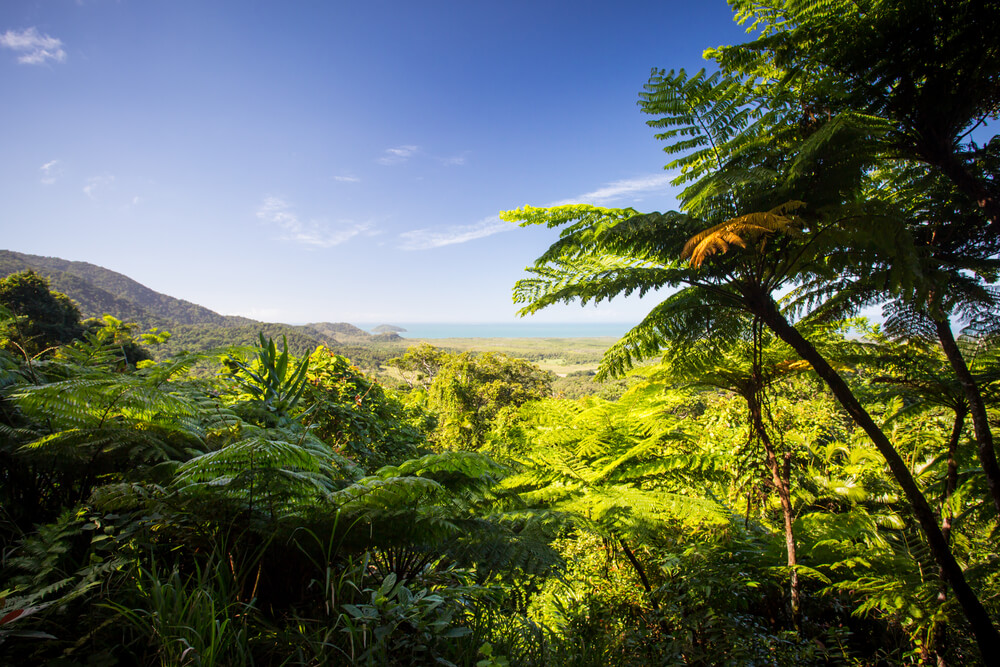
If you are like many people, you should be skeptical when hearing about a palm tree that is multi-colored. However, the Alexandra palm tree can deliver on that promise better than most palms you’ll find. The reason is that this palm tree carries large, dangling clusters of inflorescences. During different stages of development, those inflorescences can change from green to light yellow to a darker red. When multiple inflorescences at varying stages of development appear on a single tree, the result is a surprising amount of color. In addition, the Alexandra palm also has lovely fronds and a straight light grey trunk.
35. Yellow Types of Palm Trees: Latan Palm (Latania verschaffeltii)
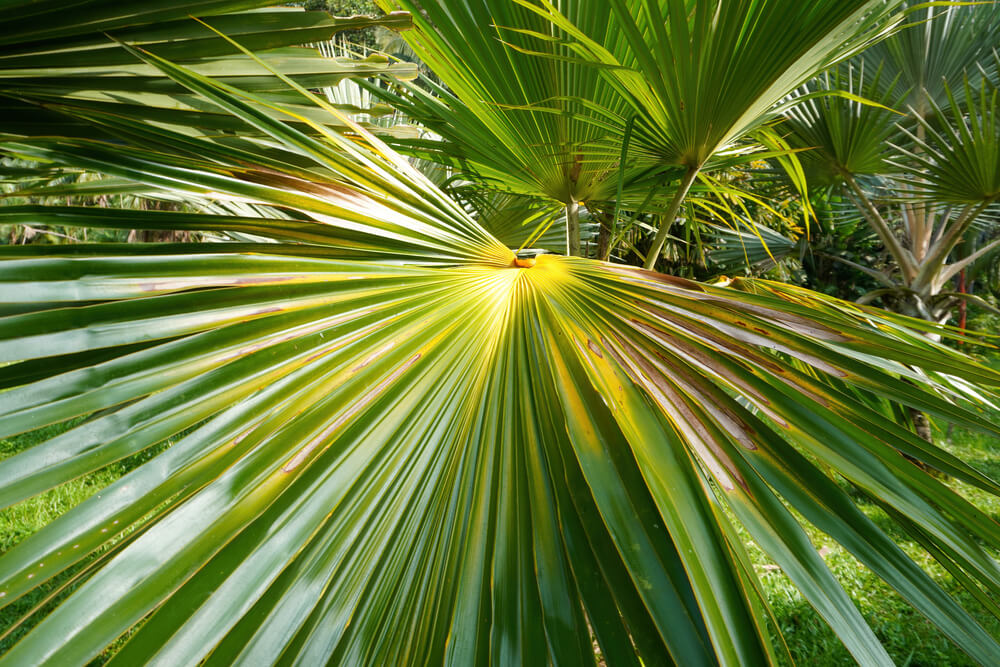
The yellow latan palm tree has fronds that are different from those of nearly any other palm tree. While almost every other frond is a single shade of green, the fronds of the yellow latan palm tree hold two tones at once. They are primarily a deep green with many golden flecks scattered throughout. That color arrangement makes the yellow latan palm tree a unique addition to any garden that is sure to impress anyone who looks at it. This species tends to get pretty large, but you won’t need to worry about it overcrowding your garden since it takes a very long time to grow.
36. Ponytail Palm (Beaucarnea recurvata)
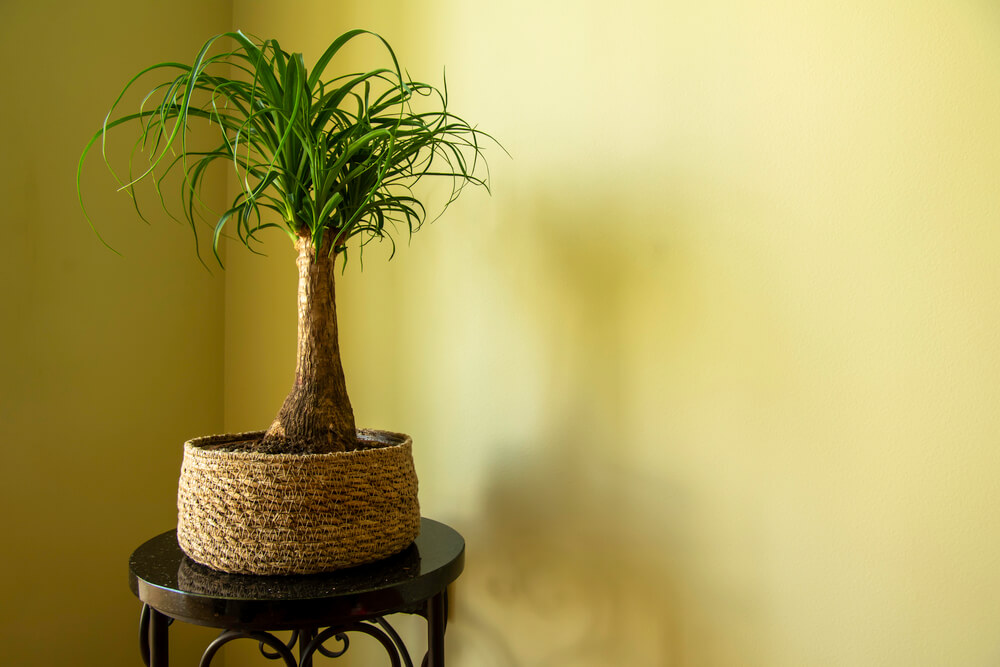
The ponytail palm is another awesome option for anyone who is looking for an indoor plant. This palm variety has an interesting set of foliage that is long, somewhat spindly and falls around the trunk much like a head of human hair. The trunk is also very fun to look at. It is generally thin, but it begins to taper out into a wide flare just above the soil line. Give this plant plenty of sunlight and plant it in a container with excellent drainage, and you should be able to raise it successfully with minimal health problems.
37. Flame Thrower Palm (Chambeyronia macrocarpa)
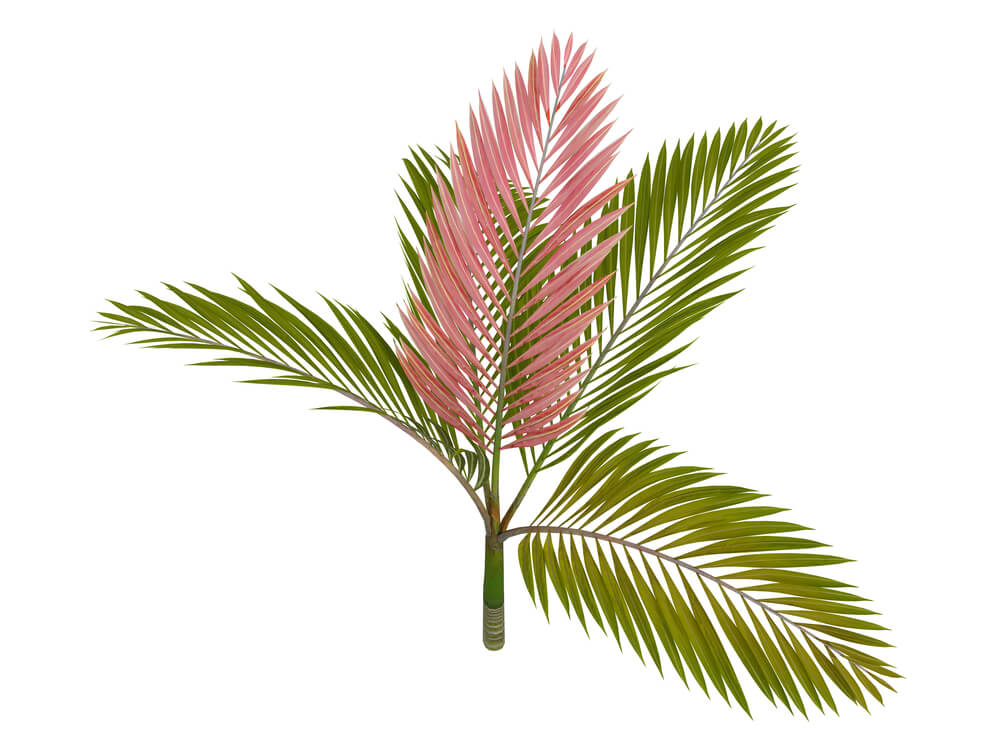
Nearly all of the flame thrower palm tree’s leaves have a dark green color, with one major exception. At the center of each tree, you’ll find a single frond full of leaflets that are a perfect red color. This single red frond makes for excellent contrast against the rest of the canopy and is the inspiration for this plant’s name due to its fiery red hue. Over time, that red frond will fade to a more typical green color, but if the timing is right, a new red frond will appear just after that.
38. Carpentaria Palm (Carpentaria acuminata)
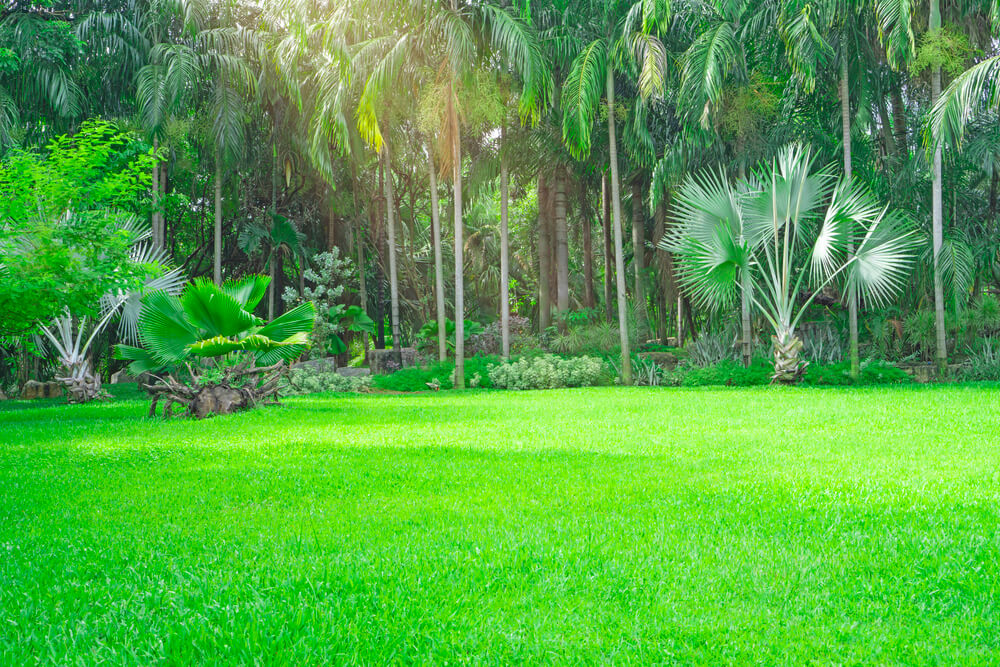
The Carpentaria palm tree is not only large, but it also does not take too long to reach its mature size thanks to its relatively fast growth rate. At the top of a smooth, lightly colored trunk, there is a set of long fronds, some of which stick out at an almost perfect 90-degree angle from the trunk. This tree also carries flower clusters that are not very colorful but do amount to a nice texture near the top of the plant. Once those flowers fade, they give way to a set of bright orange fruits that are equally numerous.
39. Traveler’s Palm (Ravenala madagascariensis)
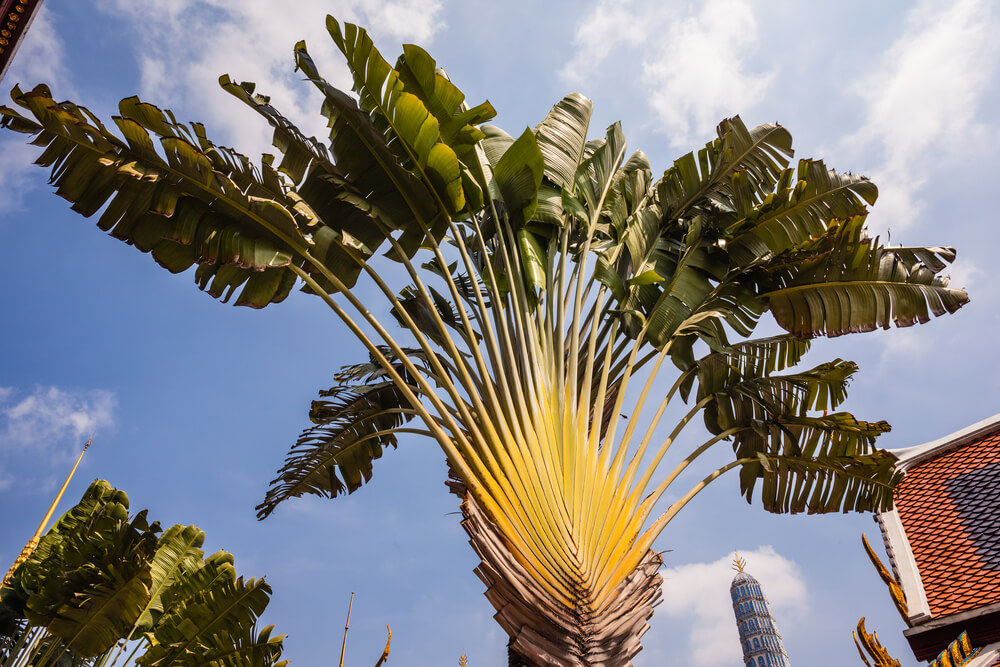
While we are near the end of our list, we still need to give mention to one of the most spectacular palm trees around. The traveler’s palm has fronds with long stems that grow in a flat, fan-like pattern. At the end of each stem, there is a leaf structure that looks a lot like a large banana leaf. This captivating growth habit ensures that you cannot miss the traveler’s palm any time you walk near it. Interestingly, this plant is more closely related to banana trees than palms, but since people often refer to it as a palm, it has earned its inclusion on this list.
40. Parlor Palm (Chamaedorea elegans)
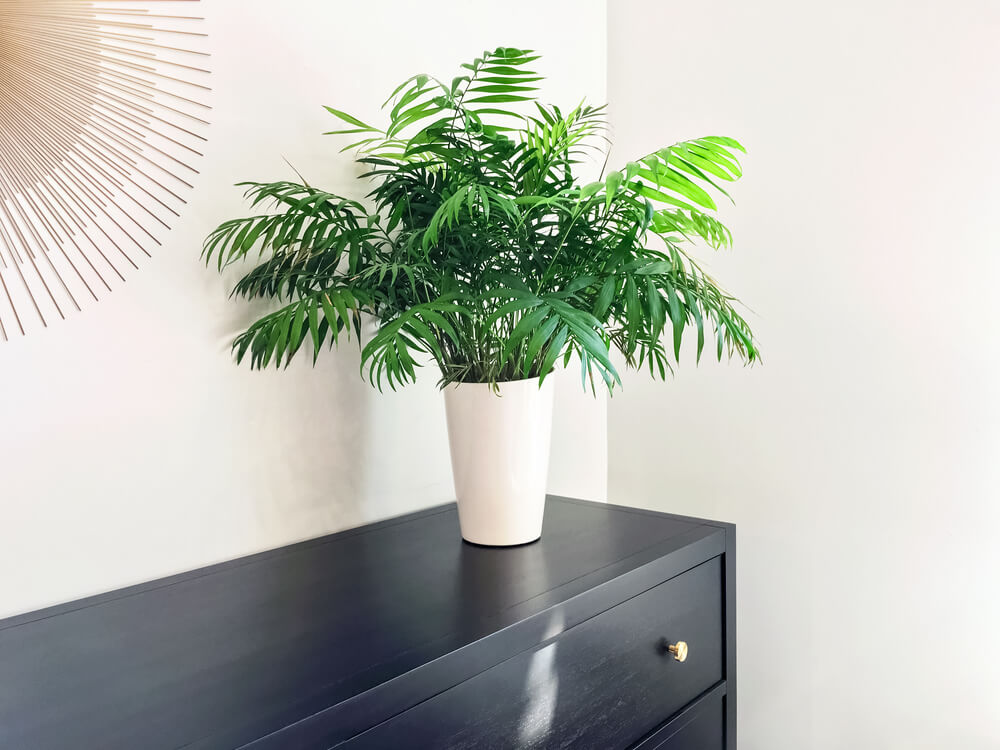
Although we have already mentioned a few great palm varieties that are suitable for indoor growth, we have yet to mention one of the most popular indoor palm options. The aptly named parlor palm is a valuable plant choice for many indoor gardening enthusiasts. In those indoor settings, the parlor palm grows to just a few feet tall and wide at most, which means it can grow in a relatively small container for most of its life. With all that said, there is no reason you can’t grow your parlor palm outdoors, as long as you live in hardiness zone 10 or warmer.
There is so much to learn about palms that a list of the 40 best palm varieties is not enough to give you well-rounded knowledge on the topic. Due to that reality, we have collected a few of the most common palm tree questions and provided some brief answers for your learning pleasure.
Frequently Asked Questions About Palm Tree Varieties
What is the Most Common Type of Palm Tree?
It is not possible to state a single most common palm tree since these plants grow in many different regions throughout the world. As such, each of those regions will have a set of palms that are more likely to arise than others. For example, in the United States, King palms, pygmy date palms, and palmetto palm trees are quite common, but there are many other palm options in that area as well.
What is the Easiest Palm to Grow?
The easiest palm to grow is one that is well suited to your growing area and receives the proper care throughout its life. But with that said, there are a few palm species that gardeners often notice being easier to care for than others. For example, the king palm, Alexandra palm, and date palm all tend to grow easily in their preferred climates. In indoor settings, the parlor palm proves to be very easy to care for as well.
Are Palm Trees Native to California?
There are some palm trees that are native to California. However, most palms come from other parts of the continent or other parts of the world. Among the California native palms, one of the most common ones is the California fan palm, which holds the botanical name Washingtonia filifera. This palm enjoys the natural regions of California, including areas such as the desert oasis and mountainous regions that fall within specific elevation ranges.
How Do Palm Trees Grow?
Most palm trees grow by sending new growth directly up through the center of the trunk at the highest part of the canopy. That new growth often takes the shape of a spike or spear and will develop into either one or more fronds. As the spear opens, the fronds begin to fan outward. As the tree develops, the spear will continue to grow upward and produce more fronds.
40 Types of Palm Trees that Grow Indoors and Out
Admittedly, the sheer amount of palm tree varieties can be quite overwhelming. It can be even more difficult to find the right palm for you. Fortunately, the incredible number of palms in existence means that there is a palm tree for nearly every gardener. Those options also feature a pleasing variety of frond shapes, colors, bark textures, and growth habits. That means that whether you garden indoors or live in an area warm enough to grow palms outdoors year-round, our list should get you started on the path toward picking the perfect palm for your garden.
